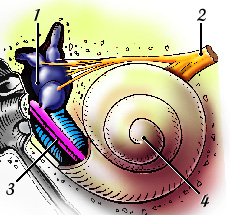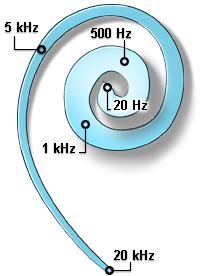| |
|
| Overview / External ear / Middle ear / Inner ear | |
| Drawings: S. Blatrix | |
| |
|
| Overview / External ear / Middle ear / Inner ear | |
| Drawings: S. Blatrix | |
|
|||||||
|
The bone has been removed to visualise the vestibule (1), the VIIIth nerve (2) , and the basal portion of the cochlear duct (3), housing the organ of Corti. The rest of the cochlea (4) is covered by the bony capsule. The VIIIth nerve is formed by the vestibular and cochlear nerves which merge before entering the brain.
|

|
 |
From base (20 kHz) to apex (20 Hz), some
characteristic frequencies are indicated. |
For permission to non-commercial use of any element of this site,
please contact us
All rights reserved © 1999 - 2007 The authors
Intellectual property law 85-660 (07/03/1985)